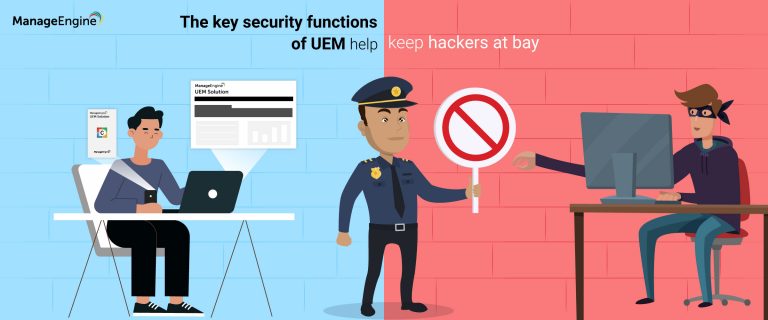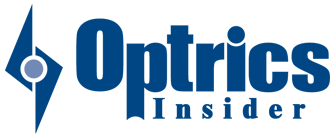As part of digital transformation, the adoption of a wide range of devices for work is on the rise. A unified endpoint management (UEM) solution is capable of enforcing management policies and configurations, as well as securing endpoints. In a previous blog, we reviewed the capabilities of a good UEM solution. In this instalment, we look at UEM security features.

Why is endpoint security critical in enterprises with multiple types of endpoints?
⇒ Most business applications have gone to the cloud. Employees using laptops, mobile devices, and other devices need to access data from anywhere, including within the office, from a remote office, or when traveling. Empowering employees to work with their devices around the clock calls for a strong security system.
⇒ Enterprise IT networks are diverse, and may contain a mix of Windows and macOS computers, as well as other platforms for mobile usage. Many enterprise networks also allow employees’ personal devices as per bring your own device (BYOD) policies. Additionally, enterprises need to manage the OS and third-party applications that employees use for work. Enhanced security helps prevent mishaps on any platform.
⇒ Organizations need to adhere to several security compliance requirements that may include implementing patching standards, device restrictions, user-level role definitions, and controls for data security. IT admins must take actions to reduce the risk of failing IT security audits.
How UEM helps secure your endpoints
UEM solutions offer many security features, including capabilities related to client management, security configuration management, and browser security.
Client management:
- Protection from malware and ransomware: By ensuring patch compliance, UEM helps keep Windows, macOS, and Linux applications up-to-date, as well as third-party applications.
- Prevention of potential vulnerabilities: To defend against cyberthreats, misconfigurations, and vulnerabilities, UEM solutions provide proactive work-arounds like tweaking firewall settings and mitigating zero-day attacks using custom scripts.
- USB device security: By enabling and disabling USB ports, you can control data being accessed by employees and prevent unexpected file corruption.
- Application blacklisting and whitelisting: By blacklisting and whitelisting applications, you can restrict what software your users can use.
- Antivirus definition installation: Silently install specific antivirus solutions, and keep your antivirus definitions updated.
Security configuration management:
UEM enables you to define security configurations such as:
- Alerts for password expiration: Issue a password warning to prompt users to reset their password before it expires.
- Firewall configurations: Regulate open ports and unwanted traffic to fend off cybercriminals.
- Custom script configurations: Utilize custom scripts and tweak registry key settings to help thwart zero-day attacks and freshly exploited cyberattacks.
Browser security:
- Browser add-on management: Detect and remove potentially harmful extensions and plug-ins from your network.
- Web filter: Protect your network from drive-by attacks by restricting access to websites or limiting downloads to trusted websites.
- Browser security configurations: Devise security configurations to prevent browsers from becoming gateways to cyberattacks.
- Compliance: Detect and remediate computers that are non-compliant with predefined security standards like CIS and STIG.
Enterprise mobility management: Securing data at rest, in transit, and in use
Managing the security of mobile endpoints such as smartphones, laptops, and tablets is different from managing the security of stationary computers. In the case of the former, more geography-specific functionalities come into play.
For data at rest:
- Passcode enforcement: Using encryption and strong passcode are some of the ways to prevent unauthorized access of data at rest.
- App authorization for data access: Prevent unauthorized apps from accessing data used by enterprise-approved apps (and vice versa) by provisioning policies.
- Containerization: By isolating personal and corporate data, you can ensure the personal data present on a user’s device is protected (especially in case of BYOD devices).
- Secure content sharing: The content management feature in mobile device management(MDM) or UEM solution can offer a secure, confidential means of sharing documents.
For data in transit:
- Secure transmission of data: With a UEM tool, you can configure VPN, per-app VPN, global HTTP proxy, etc. to ensure data is transmitted securely.
- Data wipe on stolen or misplaced devices: If a mobile device goes missing, it’s crucial to secure the data residing on the device, especially if it’s sensitive information to your enterprise. You must be able to lock, reset, wipe, or locate the device to prevent unauthorized data access.
- Geofencing: Ensure corporate data is wiped once a device leaves a specified location.
For data in use:
- Protections for mobile data: Configure security policies to restrict the use of corporate data.
- Jailbroken device restrictions: When a user jailbreaks a device, the security restrictions that were initially protecting the device are rendered useless. At the enterprise level, this could lead to vital or sensitive corporate data being compromised. Using a UEM tool, you can prevent jailbroken or rooted devices from accessing corporate data.
- Data security: By encrypting mobile corporate data, you can prevent data theft.
- BYOD security: Logical containerization enables you to manage both corporate and personal data while ensuring there is no unauthorized access or sharing of corporate data.
- Passcode enforcement: Enforcing stronger passcodes helps prevent third-party intrusions that could compromise the security of your data.
A UEM solution is an integrated platform that manages and secures all devices in an organization’s IT infrastructure, protects data in any location, and provides better visibility and control.
Introduction to ManageEngine’s UEM solution
ManageEngine Desktop Central is a UEM solution that helps you stay on top of enterprise mobility management (via features like mobile application management and MDM), as well as client management for a diverse group of endpoints, including mobile devices, laptops, computers, tablets, and servers.
** Optrics Inc. is an Authorized ManageEngine partner
The original article can be found here:

